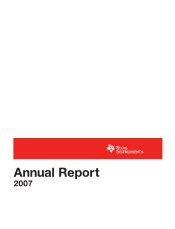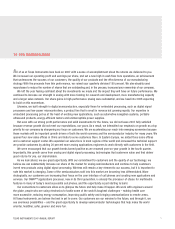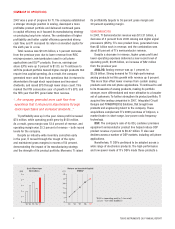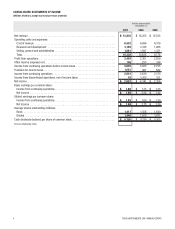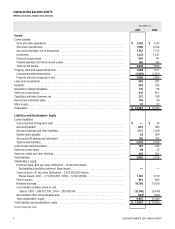Texas Instruments 2007 Annual Report Download - page 5
Download and view the complete annual report
Please find page 5 of the 2007 Texas Instruments annual report below. You can navigate through the pages in the report by either clicking on the pages listed below, or by using the keyword search tool below to find specific information within the annual report.
TEXAS INSTRUMENTS 2007 ANNUAL REPORT 3
preferred solution for customers developing a range of
applications, such as communications infrastructure
equipment, automotive navigation products and advanced
imaging systems. Most DSP customers tailor these
products to their specific applications through their own
software investments. TI’s software compatibility across
generations of DSP products ensures that customers are
able to re-use their software investments over time.
In 2007, video applications were once again an important
market for DSPs. TI added to its popular DaVinciTM product
line by introducing a new, low-cost processor that doubles
the battery life of portable, high-definition video products,
such as digital cameras and security cameras.
TI’s OMAP applications processors continue to have
a commanding lead in the cell phone market and play a
pivotal role in smartphones, the fastest growing handset
segment. Last year, TI extended its OMAP 3 platform with
products that allow cell phone manufacturers to scale their
product offerings to a range of performance levels and
price points. The products helped customers bring life-like
3-D graphics to cell phones and create a mobile gaming
experience comparable to today’s handheld gaming devices.
MANUFACTURING: TI benefited from its hybrid manufac-
turing model, with the company employing a combination of
internal and third-party foundry manufacturing for advanced
digital processes. This hybrid approach provided the company
with more flexibility in its operations to adapt to changing
market conditions yet focus its internal efforts more intently
on analog.
TI continued to enhance its analog capabilities, signifi-
cantly increasing the number of researchers involved in
analog process development while also expanding analog
manufacturing capacity. In May, TI announced plans to
increase its capacity for assembling and testing semicon-
ductors with a new facility in the Philippines that will be the
most environmentally efficient semiconductor assembly-and-
test site in the world.
EDUCATION TECHNOLOGY
TI revenue from sales of graphing calculators in its largest
market, the U.S., was slightly lower as customers reduced
inventory levels. The company made progress in France,
where TI grew sales and now holds about half the market for
graphing calculators, and in Asia, where sales were up over
25 percent. For the U.S. algebra and pre-algebra market
segments, TI introduced Math ForwardTM, an innovative pro-
gram that works directly with middle schools in several
states to close the math achievement gap between low-
and high-performing students.
In 2007, TI introduced new math learning handhelds and
software to the global market. The most notable newcomer
was the TI-NspireTM product line, which allows users to
save their work, link to data banks and view mathematical
problems in different representations, such as algebraic
or geometric.
Revenue for this segment was $526 million, about even
with the prior year’s level. Gross profit was up by $19 million
to $340 million, or a record 64.6 percent of revenue. Operat-
ing profit grew by $8 million to $208 million, or a record
39.4 percent of revenue. This marks the eleventh straight
year that Education Technology improved profitability, both
in gross margin and operating margin.
“
TI continued to add to its thousands of analog products,
making its portfolio stronger, more differentiated and
more attractive to a broader set of customers.”

